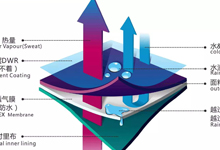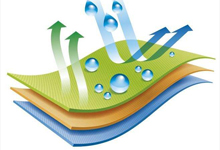Textile dry goods | Do you know all these conventional textile fibers?
Textile dry goods | Do you know all these conventional textile fibers?
Viscose fiber

Part.1
1. Ordinary viscose fiber:
(1) The cut length of viscose cotton type short fiber is 35~40mm, the fineness is 1.1~2.8dtex (1.0~2.5 denier) and blended with cotton to make fine cloth, validin, gabardine, etc.
(2) Viscose wool type short fiber, cut length 51~76mm, fineness 3.3~6.6dtex (3.0~6.0 denier), can be spun purely or blended with wool, and can be made into tweed, coats, etc.
2. Rich and strong fiber:
(1) It is an improved variety of viscose fiber.
(2) Pure spinning can be used to make fine cloth, poplin, etc.
(3) Blended with cotton, polyester, etc. to produce various clothing.
(4) It has good alkali resistance, and the fabric is stiff and will not shrink or deform after washing, making it more durable.
3. Viscose yarn:
(1) Can be used for clothing, quilt covers, bedding and decorations.
(2) Viscose yarn and cotton yarn are interlaced to make feather yarn and thread quilt top.
(3) Viscose silk and silk are interwoven to make georgette, brocade, etc.
(4) Viscose threads are interwoven with polyester and brocade filaments to make crystal satin, antique satin, etc.

4. Viscose strong yarn:
(1) The strength is twice as high as ordinary viscose yarn.
(2) Twisted and woven into cord fabric, used for automobile, tractor and carriage tires.
polyester fiber
Part.2
1. Short fiber:
It can be spun purely, but is usually blended with cotton, wool, viscose and other fibers to improve its wearing properties.
(1) Cotton fiber
1.65~2.2dtex(1.5~2.0D)×35~40mm
Mainly polyester-cotton blends, with a blending ratio of 65% to 67% polyester and 35% to 33% cotton. It can also be blended in other proportions.
High strength and low elongation type:
High strength, small elongation, good spinnability of cotton, high quality index of spun yarn, crisp, smooth and good shape retention of the fabric. It is mainly used for blending with cotton. Depending on the specifications, it can be spun into various light and smooth clothing materials. , high-strength knitting yarn, sewing thread, etc.
Low strength and high stretch type:
The fabric has good dyeability, soft hand feel, abrasion resistance, impact resistance, not easy to pilling, good wearing performance, but low strength and many yarn breakages. It is mainly used for blending with wool and viscose.
(2) Medium and long type
2.2~3.3dtex(2~3D)×51~76mm
It is mainly used for blending with wool-type viscose fiber. The blending ratio is roughly the same as the cotton-polyester blending ratio. In order to reduce the price of finished products and fabrics, viscose fiber can be increased to 50%. Fabrics used for sewing outerwear, casual clothes, shirts, skirts, sportswear, etc.
(3) Hair type
2.75~4.4dtex(2.5~4D)×35~40mm
Mainly used for blending with wool. The blending ratio is: polyester 45%~55%, wool 55%~45%. The fabric is mainly used for sewing outerwear. In addition to the above uses, polyester short fiber can also be combined with other natural fibers and natural fibers. Blended with scraps and other fibers, it can also be blended with two other fibers to prepare a three-in-one fabric. With the development of new varieties, some of the shortcomings of polyester are being improved and its uses are broader.

2. Filament
Including pre-oriented yarn (POY) and drawn yarn (DTY), which are mainly used to process into low elasticity yarn for weaving, and can also be directly woven or knitted.
(1) Conventional silk
110~165dtex (100~150D) or above, suitable for making all kinds of wool-like fabrics and other medium-thick clothing materials
78.4~82.5dtex (68~75D) Suitable for general clothing materials
33~55dtex (30~50D) Suitable for making various thin imitation silk fabrics, underwear materials, quilt tops, decorative fabrics, etc.
(2) Special-shaped wire
The cross-section of the silk is different from the conventional circular cross-section. There is a triangular cross-section with sufficient mercerization, which is suitable for making various imitation silk fabrics; the multi-leaf cross-section has good covering properties, the fabric is soft, elastic, and has a strong sense of wool shape, so it is suitable for processing wool-like products; Hollow-shaped cross-section fibers are light, soft, have good thermal insulation properties and good resilience. They can be used to imitate down and be used as batting, batting, pillow cores, etc.
(3) Air textured yarn
The individual filaments are entangled with each other, forming a textured yarn with small loops of filaments on the surface of the yarn. This yarn not only retains the advantages of polyester such as high strength, good wear resistance, crisp fabric, easy washing and quick drying, but also overcomes the shortcomings of polyester low elasticity such as aurora, waxy feel and poor air permeability that cannot be overcome. It can be woven and knitted directly, eliminating the need for curling, cutting, packaging, and then sending to the textile factory for multiple processes such as blow cleaning, steel wire, drawing, roving, and spun yarn. The fabric produced can rival fine yarn in terms of comfort, silk-like appearance, bulkiness and covering performance. Fabrics made of imitation wool not only feel and look like pure wool fabrics, but are also of high quality and low price.
(4) Network silk (starch-free silk)
The cohesion between monofilaments is high and the bundling is good. It can be woven or knitted directly, saving money.However, twisting, sizing and other processes are included. Depending on the fabric, silk, Paris, gabardine, patterned tweed, etc. can be woven.
(5) Mixed fiber yarn (colorful yarn)
Utilizing the various characteristics of synthetic fibers, modified, textured, multifilament or chemical fibers with different components or different cross-sections, different shrinkage rates, and different glosses and colors are produced in the form of random, block, sheath-core, juxtaposition, etc. Plied or twisted together, the product variations are endless. According to different yarn colors, fabrics with different effects can be woven, and fabrics such as wool-like, silk-like, linen-like fabrics can be produced.







